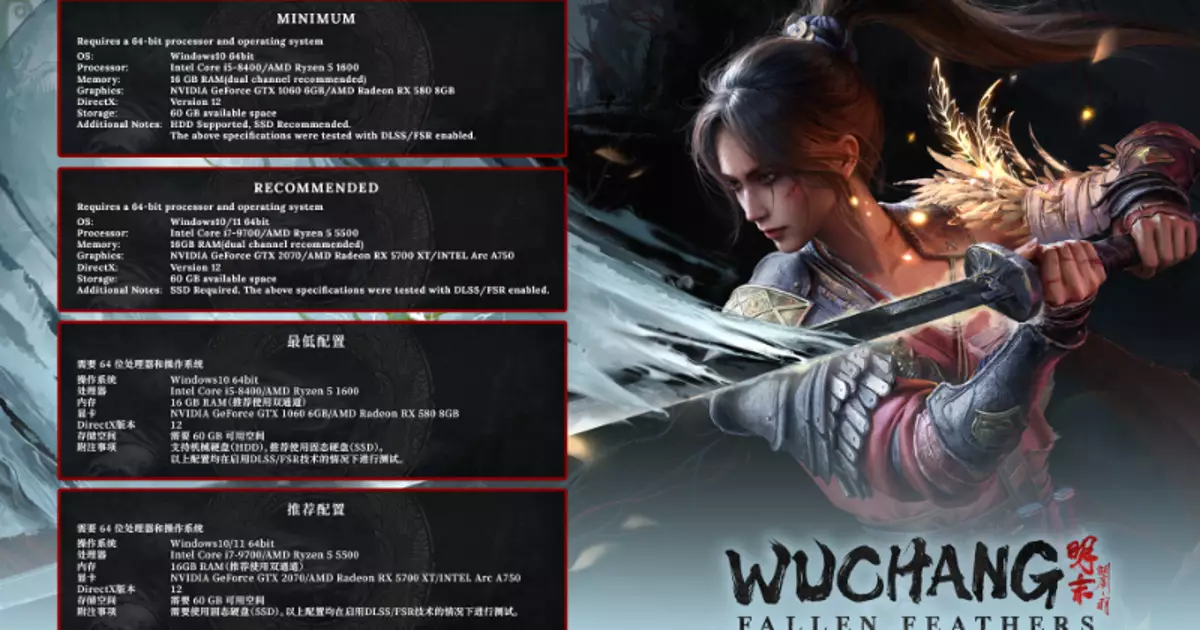Wuchang: Fallen Feathers promises to blend rich Chinese historical influences with dark, fantastical horror in a way that feels both nostalgic and innovative. Unlike traditional action RPGs that often lean heavily on Western mythos, this game stakes a claim by immersing players in the tumultuous Ming dynasty era with a distinctly supernatural twist. The premise of a amnesiac pirate swordswoman fighting “feathered” plague-infested enemies offers a compelling mix of lore, combat, and narrative exploration. What sets Wuchang apart from its peers is its unapologetic embrace of a unique aesthetic and thematic boldness: a plague that bestows feathers upon its victims, transforming them into monstrous avian entities. This creative concept not only enriches the world-building but challenges players to confront bodily transformation and moral ambiguity—elements that elevate its gameplay beyond mere hack-and-slash.
The developers, Leenzee, have iteratively refined the game’s visuals, attempting to strike a balance between atmospheric dark fantasy and accessibility. Their goal appears to be a visual identity that hints at Bloodborne’s gothic horror while steering clear of rote tropes, offering instead a distinct Chinese setting called Shu. This setting, once marked by crimson-red hues reminiscent of Yharnam, has been stylized anew to evoke a different mood—less oppressive, yet equally intense. Such aesthetic choices demonstrate a thoughtful effort to craft an immersive environment that echoes the game’s themes of decay, transformation, and mystery.
Gameplay Mechanics That Push Boundaries and Invite Player Agency
Wuchang’s gameplay conceptually mirrors the encounter-heavy, boss-centric design of FromSoftware’s titles, but it carves its own identity through Chinese lore and the visceral theme of feathering. Recalling Bloodborne’s relentless pace and punishing difficulty, Wuchang emphasizes skill, strategic weapon enchantments, and the uncovering of secrets through exploration. The use of “Red Mercury” to unlock new techniques hints at a gameplay cycle rooted in both resource management and discovery, pushing players to experiment with diverse combat styles.
What truly intrigues me is the game’s narrative flexibility. The choices players make—who to trust, which secrets to reveal, how to confront enemies—shape multiple endings. This branching storytelling invites replayability and personal investment. Unlike many linear RPGs, Wuchang’s emphasis on agency fosters a sense of ownership in a narrative that’s as much about moral dilemmas as it is about physical confrontations.
Furthermore, the upgrade system, which allows weapon enchantments, adds depth to combat. These upgrades seem to serve not only as power boosts but also as narrative hooks—you might be inflicting greater damage, but at what moral or strategic cost? The inclusion of “Red Mercury” as an unlock mechanic indicates a hybrid of scientific mysticism and folklore, harmonizing tradition with innovation.
System Requirements and Technological Expectations: A Balanced Demand
Turning to the technical side, Wuchang’s system requirements are surprisingly accessible for a modern action RPG that promises eye-catching visuals. The minimum specs demand only an Intel Core i5-8400 and a GTX 1060 graphics card, which are fairly commonplace in gaming PCs today. This suggests that the developers want their game to reach a broad audience without forcing players into costly upgrades. Interestingly, the recommended specs escalate to a much beefier setup—an i7-9700 and a RTX 2070—implying that the game is designed to shine with higher-end hardware, especially in terms of visual fidelity and performance.
The mention of DLSS 4 support opens a window into Wuchang’s technological aspirations. DLSS (Deep Learning Super Sampling) can drastically improve frame rates and image quality, helping to maintain game fluidity during intense combat sequences. This indicates that the game intends to push graphical boundaries without sacrificing performance, which is crucial given the high-speed, reflex-demanding gameplay.
What’s notable here is that the game supports SSDs over HDDs, aligning with current industry standards. As game worlds become more detailed and data-heavy, fast storage solutions will be vital for seamless immersion—a sign that the developers are invested in delivering a polished experience. Yet, they also recognize that not all players have access to top-tier hardware, making the game accessible at lower specs while still offering a premium experience for those with more advanced setups.
A Unique Cultural Lens and Personal Reflections
Beyond the mechanics and technical details, Wuchang offers a compelling cultural perspective. Its setting allows for exploration of Chinese mythology intertwined with the plague narrative—an imaginative canvas that can deepen understanding of eastern folklore. The idea of a protagonist unraveling her past amid a society plagued by feathers and monstrous transformation is not only thrilling but also emotionally resonant.
From my perspective, the game’s emphasis on choices and multiple endings suggests a penchant for narrative complexity that may distinguish it from other action titles. While the inspiration from Bloodborne is evident, Wuchang’s cultural specificity and aesthetic direction can make it feel fresh and personalized. The notion of a hero fighting against a bodily curse that elevates her enemies—and possibly herself—adds layers of thematic depth that could make the gameplay more meaningful.
Wuchang: Fallen Feathers demonstrates a promising merger of innovative storytelling, thematic richness, and accessible yet performant game mechanics. Its system requirements balance appeal and technical feasibility, ensuring that a broad spectrum of players can experience its darkly beautiful world. The game’s unique cultural lens combined with its creative design choices point toward an engaging and memorable journey, one that could carve out a distinct space within the crowded action RPG genre.

